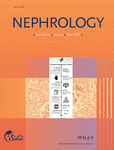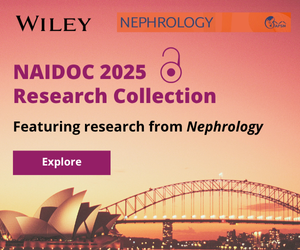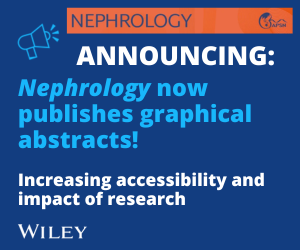Journal list menu
Export Citations
Download PDFs
Issue Information
EDITORIALS
#PatientsIncluded: Patient involvement in nephrology conferences
- Pages: 367-368
- First Published: 07 February 2020
We want to be part of the solution, not just be the problem: Why patients need to be involved in scientific conferences?
- Pages: 369-370
- First Published: 29 April 2019
Original Articles
CLINICAL NEPHROLOGY
Peripheral arterial stiffness is correlated with intrarenal arteriolosclerosis according to biopsies from patients with kidney disease
- Pages: 371-378
- First Published: 01 October 2019
In this single centre cross-sectional study, the relationship between clinical and pathological measures of vascular disease was assessed using kidney biopsies and peripheral arterial tonometry, respectively. Patients more severe biopsy-proven arteriolosclerosis had greater vascular stiffness after multivariable adjustment. Peripheral arterial tonometry may be useful as a noninvasive measure of intrarenal arteriolosclerosis.
Brief Communication
CLINICAL NEPHROLOGY
‘Knowledge is power’: A framework for partnering with consumers in developing and delivering a scientific meeting in nephrology
- Pages: 379-383
- First Published: 29 January 2019
Original Articles
ACUTE KIDNEY INJURY
Urinary chloride concentration as a prognostic marker in critically ill patients
- Pages: 384-389
- First Published: 31 October 2019
This article demonstrates a new role for urinary chloride excretion in predicting mortality in the intensive care unit setting. Lower urinary chloride (less than 53 mEq/L) is associated with a higher mortality. This finding may be explained by the mechanisms of renal hypoperfusion, impaired tubuloglomerular feedback and excessive upregulation of pendrin.
CHRONIC KIDNEY DISEASE
The association between dietetic consultation and time to dialysis for patients attending a pre-dialysis clinic: A retrospective cohort study
- Pages: 390-397
- First Published: 28 July 2019
In this study, the impact of dietetic consultation on time to dialysis for patients attending a pre-dialysis clinic was investigated. The authors found that dietetic consultation provided to patients was associated with a delayed time to dialysis. They concluded that standardized referral pathways to improve patient access to renal dietetic services were recommended to optimize care.
Expression and clinical value of gastrin-releasing peptide precursor in nephropathy and chronic kidney disease
- Pages: 398-405
- First Published: 14 August 2019
Serum pro-gastric releasing peptide increases with declining glomerular filtration rate both in acute and chronic kidney disease in a Chinese population. However, it is not superior to the creatinine-based modification of diet in renal disease formula for predicting renal function.
DIALYSIS
Current practice in dialysis central venous catheter management: Multi-disciplinary renal team perspectives
- Pages: 406-412
- First Published: 01 July 2019
A semi-structured interview study on the perspectives of clinicians on the management of central venous catheters in patients on dialysis. Multidisciplinary involvement in the insertion, maintenance and removal of catheters can support better management of central venous catheters for patients on dialysis.
Effects of early detection of peritoneal catheter migration on clinical outcomes: 15-years experiences from a single centre
- Pages: 413-420
- First Published: 01 July 2019
In this retrospective study of 135 peritoneal dialysis patients, serial X-rays were used for early detection of catheter migration. In over 90% patients, conservative management with rigorous catharsis (defined as an increase in stool frequency more than four times a day) was successful in restoring normal catheter position and function when the problem is identified early.
Socioeconomic status and dialysis quality of care
- Pages: 421-428
- First Published: 01 July 2019
This study was designed to test whether the quality of care delivered to dialysis patients varied by socioeconomic status among 19 486 patients commencing haemodialysis or peritoneal dialysis between 2002 and 2012, as recorded in Australia and New Zealand Dialysis and Transplant Registry (ANZDATA). The conclusion showed socioeconomic status has minimal impact on quality of care. Increased mortality in lower SES groups may be due to pre-dialysis factors and other variables such as health-related behavior, lifestyle and literacy.
CORRESPONDENCE
IgGκ light and heavy chain amyloidosis secondary to a B-cell lymphoproliferative disorder, whole picture on a renal biopsy
- Pages: 429-430
- First Published: 14 November 2019







